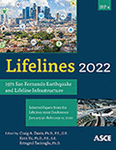Comparative Study on Seismic Performance Analysis Methods of Water Distribution Systems
Publication: Lifelines 2022
ABSTRACT
Seismic performance analysis of water distribution system (WDS) is an essential step in the seismic design and resilience evaluation of WDS. Network connectivity reliability analysis and the flow-based hydraulic simulation methods are widely used in the seismic performance analysis of WDS. Many researchers choose one of these methods for seismic performance evaluation of WDS, but the comparison between the application results of these two methods is insufficient. This work compares the analysis results of the two methods through the application of benchmark WDS cases in which the connectivity reliability and the water demand performance of user nodes are used as quantitative measures; the two methods were conducted based on the Monte Carlo Simulation to consider the uncertainty of seismic damages of pipelines. Three widely-used benchmark WDSs (Modena, C-Town, Exnet) with different characteristics were used for case study. Through the application results of the benchmark WDSs under different seismic damage scenarios, the correlation, consistency, and statistical characteristics between the results of the two methods were compared. The results show that the correlation and consistency between the connectivity reliability and the water demand performance measure is low; the seismic connectivity reliability usually has a larger value than that of the water demand performance; user nodes with lower connectivity reliability may not necessarily have lower levels of water demand performance. The hydraulic simulation method is considered to be a more reliable analysis method because it includes both the geometry topology of pipelines and the hydraulic characteristics of WDS.
Get full access to this article
View all available purchase options and get full access to this chapter.
REFERENCES
Adachi, T., and Ellingwood, B. R. (2008). “Serviceability of earthquake-damaged water systems: Effects of electrical power availability and power backup systems on system vulnerability.” Reliab. Eng. Syst. Safe., 93(1), 78–88.
ALA (American Lifeline Alliance). (2001). Seismic Fragility Formulations for Water Systems: Guidelines. American Lifelines Alliance and Federal Emergency Management Agency (FEMA), ASCE, Reston, VA.
Bragalli, C., D’Ambrosio, C., Lee, J., Lodi, A., and Toth, P. (2012). “On the optimal design of water distribution networks: A practical MINLP approach.” Optim. Eng., 13(2), 219-246.
CNSA (China National Standardization Administration). (2008). The Chinese Seismic Intensity Scale (GB/T 17742). Standards Press of China, Beijing, China.
Farmani, R., Savic, D. A., and Walters, G. A. (2004). ““EXNET” Benchmark Problem for Multi-Objective Optimization of Large Water Systems.” Modelling and Control for Participatory Planning and Managing Water Systems, IFAC workshop, Venice, Italy.
Han, Z., Ma, D. H., Hou, B. W., and Wang, W. (2020). “Seismic resilience enhancement of urban water distribution system using restoration priority of pipeline damages.” Sustainability, 2020, 12(3), 914.
Isoyama, R., Ishida, E., Yune, K., and Shirozu, T. (2000). “Seismic damage estimation procedure for water supply pipelines.” Proc. Proceedings of the 12th World Conference on Earthquake Engineering, Auckland, New Zealang, 18, 63–68.
Jeon, S.-S., and O’Rourke, T. D. (2005). “Northridge earthquake effects on pipelines and residential buildings.” B. Seismol. Soc. Am., 95(1), 294–318.
Laucelli, D., and Giustolisi, O. (2015). “Vulnerability assessment of water distribution networks under seismic actions.” J. Water Resour. Plan. Manag., 141(6), 04014082.
Lim, H.-W., and Song, J. (2012). “Efficient risk assessment of lifeline networks under spatially correlated ground motions using selective recursive decomposition algorithm.” Earthq. Eng. Struct. Dyn., 41(13), 1861–1882.
Meijer, D., van Bijnen, M., Langeveld, J., Korving, H., Post, J., and Clemens, F. (2018). “Identifying critical elements in sewer networks using graph-theory.” Water, 10(2), 136.
Meng, F. L., Fu, G. T., Farmani, R., Sweetapple, C., and Butler, D. (2018). “Topological attributes of network resilience: A study in water distribution systems.” Water Res. 2018, 143, 376-386.
O’Rourke, M. J., and Liu, X. (1999). “Response of buried pipelines subject to earthquake effects.” Monograph series/ Multidisciplinary Center for Earthquake Engineering Research, Multidisciplinary Center for Earthquake Engineering Research: Buffalo, NY, ISBN 0-9656682-3-1.
Ostfeld, A., Salomons, E., Ormsbee, L., and Uber, J. G. (2011). “Battle of the water calibration networks.” J. Water Resour. Plan. Manag., 138(5), 523-532.
Pagano, A., Sweetapple, C., Farmani, R., Giordano, R., and Butler, D. (2019). “Water distribution networks resilience analysis: A comparison between graph theory-based approaches and global resilience analysis.” Water Resour. Manag., 33, 2925–2940.
Rossman, L. (2002). EPANET 2.0 User Manual. United States Environmental Protection Agency, Cincinnati, OH, USA.
Shi, P. X., and O’Rourke, T. D. (2008). “Seismic Response Modeling of Water Supply Systems.”, University at Buffalo, State University of New York, NY, USA.
Shinozuka, M., Tan, R. Y., and Toike, T. (1981). “Serviceability of Water Transmission Systems under Seismic Risk.” In Lifeline Earthquake Engineering: the Current State of Knowledge, American Society of Civil Engineers, NY, USA.
Shuang, Q., Liu, H. J., and Porse, E. (2019). “Review of the Quantitative Resilience Methods in Water Distribution Networks.” Water, 11(6), 1189.
Sun, H. (2004). Graph Theory and its Application. Science Press, Beijing, China.
Takada, S., and Tanabe, K. (1987). “Three-dimensional seismic response analysis of buried continuous or jointed pipelines.” J. Pressure Vessel Technol.,109(1),80–87.
Wagner, J. M., Shamir, U., and Marks, D. H. (1988). “Water distribution reliability: simulation methods.” J. Water Resour. Plan. Manag., 114(3), 276-294.
Wang, Y., and O’Rourke, T. D. (2008). “Seismic performance evaluation of water supply systems.”, University at Buffalo, State University of New York, NY, USA.
Yoo, D. G., Kang, D., and Kim, J. H. (2016). “Optimal design of water supply networks for enhancing seismic reliability.” Reliab. Eng. Syst. Safe., 146, 79-88.
Information & Authors
Information
Published In
History
Published online: Nov 16, 2022
Authors
Metrics & Citations
Metrics
Citations
Download citation
If you have the appropriate software installed, you can download article citation data to the citation manager of your choice. Simply select your manager software from the list below and click Download.
